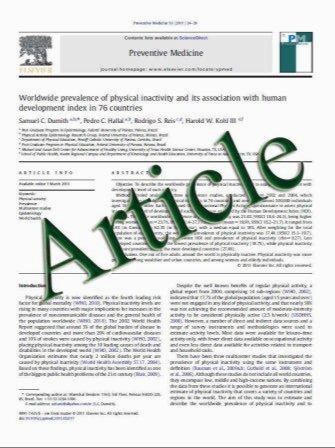Thrombin generation in ankylosing spondylitis
- نوع فایل : کتاب
- زبان : انگلیسی
- مؤلف : Clément Prati & Evelyne Racadot & Jean-Pierre Cedoz & Daniel Wendling
- چاپ و سال / کشور: 2011
Description
Ankylosing spondylitis (AS) is a chronic inflammatory disease associated with an increase in cardiovascular risk. Thrombin generation is associated with the risk of thrombosis, and the endogenous thrombin potential (ETP) has been proposed as a parameter for plasma-based hypercoagulability. The aim of the study was to evaluate the risk of thrombosis in a group of AS patients in comparison to healthy subjects and to look for factors associated with an increased risk. Patients with AS fulfilling revised New York criteria were included in the study. Age, sex, disease duration, presence of peripheral arthritis and of extra-articular manifestation, and treatment were recorded, as well as HLA-B27 positivity, ESR, CRP, IgA, D-dimer levels, and bath ankylosing spondylitis disease activity index (BASDAI) score. Control patients were healthy blood donors. Patients with thrombosis history or with antithrombotic treatment were excluded. Endogenous thrombin generation was studied using a fluorometric technique (Technothrombin TGA kit, Technoclone, Austria). The thrombin generation parameters were ETP, corresponding to the area under the curve (nanomole per liter); lag time, corresponding to the initiation of the thrombin generation (minutes); maximal concentration of thrombin generated (Cmax, nanomole per liter); the time to reach the peak (Tmax, minutes); and the maximal rising slope of thrombin generation (velocity). Statistical analysis used Student’s t test for comparisons, and Spearman’s correlation test for the correlations; p values less than 0.05 were considered significant. Forty-six AS outpatients were included, 38 men with a mean (SD) age of 43.5±13.1 years and a mean disease duration of 14.1±8.4 years; ESR=22.2±17.2 mm, CRP=14.5±7.3 mg/l, and BASDAI=37.8±21.7 mm. Twelve had peripheral arthritis, and 17 had extra-articular involvement (IBD, uveitis, and psoriasis). Thirty-nine are HLA-B27 positive, 28 are under NSAIDs alone, and 15 were under TNF blockers at time of evaluation. Control group was 24 healthy blood donors. There is no difference between AS and controls for ETP, Cmax, and velocity. There is an increase in lag time (p=0.03) and T max (p= 0.04) in AS patients. There is no difference in thrombin generation parameters between axial and peripheric AS, or between anti-TNF treated and not treated patients. Correlations were found between ETP and ESR (p=0.006), CRP (p=0.05), and BASDAI (p=0.01); between Cmax and ESR, CRP, and BASDAI; between velocity and ESR; and between D-dimers and ESR and CRP. Even if there are some correlations between thrombin generation parameters and biological and clinical activity, this study does not demonstrate an increase in thrombin generation in patients with AS compared with controls. Moreover, the findings of higher lag time and Tmax in the patients may argue for a delayed thrombin generation in AS.
Clin Rheumatol (2011) 30:511–514 Received: 14 October 2009 / Revised: 13 July 2010 / Accepted: 4 August 2010 / Published online: 17 August 2010


